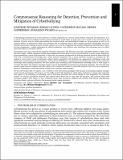Commonsense Reasoning for Detection, Prevention, and Mitigation of Cyberbullying
Author(s)
Dinakar, Karthik; Jones, Birago; Havasi, Catherine; Picard, Rosalind W.; Lieberman, Henry A
DownloadPicard_Common sense.pdf (1.747Mb)
OPEN_ACCESS_POLICY
Open Access Policy
Creative Commons Attribution-Noncommercial-Share Alike
Alternative title
Common Sense Reasoning for Detection, Prevention, and Mitigation of Cyberbullying
Terms of use
Metadata
Show full item recordAbstract
Cyberbullying (harassment on social networks) is widely recognized as a serious social problem, especially for adolescents. It is as much a threat to the viability of online social networks for youth today as spam once was to email in the early days of the Internet. Current work to tackle this problem has involved social and psychological studies on its prevalence as well as its negative effects on adolescents. While true solutions rest on teaching youth to have healthy personal relationships, few have considered innovative design of social network software as a tool for mitigating this problem. Mitigating cyberbullying involves two key components: robust techniques for effective detection and reflective user interfaces that encourage users to reflect upon their behavior and their choices.
Spam filters have been successful by applying statistical approaches like Bayesian networks and hidden Markov models. They can, like Google’s GMail, aggregate human spam judgments because spam is sent nearly identically to many people. Bullying is more personalized, varied, and contextual. In this work, we present an approach for bullying detection based on state-of-the-art natural language processing and a common sense knowledge base, which permits recognition over a broad spectrum of topics in everyday life. We analyze a more narrow range of particular subject matter associated with bullying (e.g. appearance, intelligence, racial and ethnic slurs, social acceptance, and rejection), and construct BullySpace, a common sense knowledge base that encodes particular knowledge about bullying situations. We then perform joint reasoning with common sense knowledge about a wide range of everyday life topics. We analyze messages using our novel AnalogySpace common sense reasoning technique. We also take into account social network analysis and other factors. We evaluate the model on real-world instances that have been reported by users on Formspring, a social networking website that is popular with teenagers.
On the intervention side, we explore a set of reflective user-interaction paradigms with the goal of promoting empathy among social network participants. We propose an “air traffic control”-like dashboard, which alerts moderators to large-scale outbreaks that appear to be escalating or spreading and helps them prioritize the current deluge of user complaints. For potential victims, we provide educational material that informs them about how to cope with the situation, and connects them with emotional support from others. A user evaluation shows that in-context, targeted, and dynamic help during cyberbullying situations fosters end-user reflection that promotes better coping strategies.
Date issued
2012-09Department
Massachusetts Institute of Technology. Media Laboratory; Program in Media Arts and Sciences (Massachusetts Institute of Technology)Journal
ACM Transactions on Interactive Intelligent Systems
Publisher
Association for Computing Machinery (ACM)
Citation
Karthik Dinakar, Birago Jones, Catherine Havasi, Henry Lieberman, and Rosalind Picard. 2012. Common Sense Reasoning for Detection, Prevention, and Mitigation of Cyberbullying. ACM Trans. Interact. Intell. Syst. 2, 3, Article 18 (September 2012), 30 pages.
Version: Author's final manuscript
ISSN
21606455